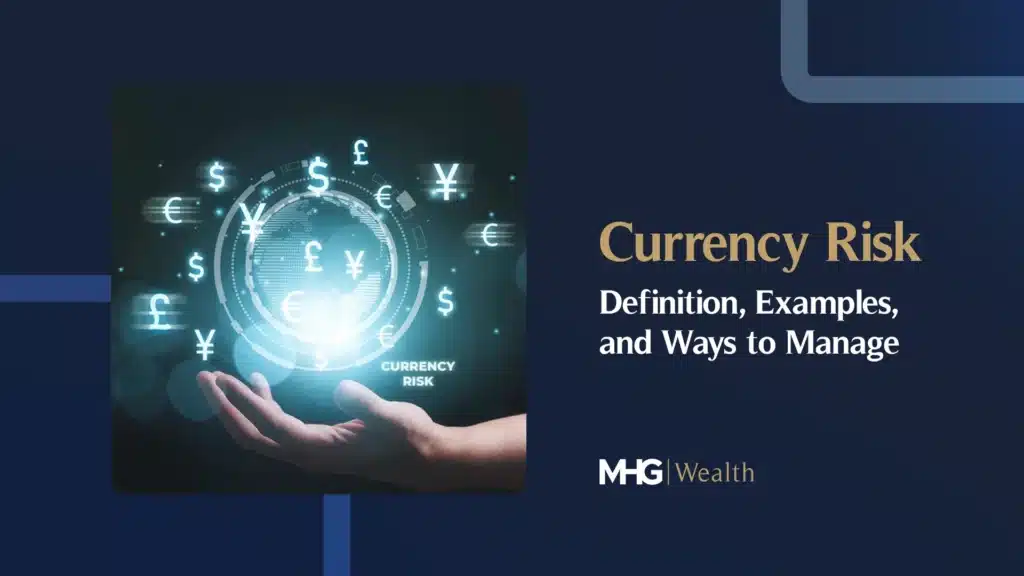In today’s interconnected world, businesses are going global, investments are crossing borders, and our lives are intertwined with the international financial system. But with this interconnectedness comes a hidden risk: currency risk.
Whether you’re investing abroad, running a business with global suppliers, or planning an international vacation, fluctuations in currency values can impact you more than you think.
So, understanding currency risk is like wearing a life jacket in a stormy sea. It can protect your wealth and help you make smarter financial decisions. We’ll break down currency risk—what it is, why it matters, and how you can manage it effectively to protect your wealth and interests.
What is Currency Risk?
Currency risk, also known as exchange rate risk, refers to the financial risk that arises from changes in the value of one currency relative to another.
This can occur in international transactions, investments, or any situation where multiple currencies are involved. When the exchange rates fluctuate, it can lead to unexpected gains or losses.
Understanding Currency Risk
Imagine you’re a business owner in the UAE who imports goods from the UK. You agree on a price of £10,000 for a shipment of products. At the time of the deal, the exchange rate is fixed at a known rate, but by the time you make the payment, it may have shifted, leading to unexpected costs. This is currency risk in action.
Types of Currency Risk
1. Currency Conversion Risk
This type of risk occurs when converting one currency into another. For example, a UAE-based investor who invests in U.S. stocks will face currency conversion risk when converting profits back into dirhams.
2. Foreign Currency Risk
Foreign currency risk happens when the value of a foreign currency fluctuates relative to your home currency. Suppose you’re an investor holding foreign bonds, for example. In that case, any drop in the value of that foreign currency can reduce the overall return on your investment, even if the bonds themselves perform well.
3. Currency Exchange Rate Risk
This is the risk that the exchange rate between two currencies will move against you. Imagine you’re planning a trip to the UK and want to exchange your UAE Dirhams for British Pounds. You exchange AED 1,000 for £200, based on the current exchange rate of 1 AED = 0.2 GBP.
Now, let’s say you spend £100 on your trip and have £100 left. When you return home, you want to convert your remaining pounds back into dirhams. If the exchange rate has changed to 1 AED = 0.25 GBP, you’ll now receive AED 400 for your £100.
In this scenario, you’ve experienced a currency exchange rate loss. If you had exchanged your pounds back at the original rate of 1 AED = 0.2 GBP, you would have received only AED 200.
On the other hand, if the exchange rate had moved in your favor, say to 1 AED = 0.15 GBP, you would have received more dirhams when you converted your pounds back.
Examples of Currency Risk
Currency risk plays out in numerous ways across different sectors. Let’s look at some real-world examples.
-
A Tech Company’s Global Sales
A U.S.-based tech company that sells products across Europe and Asia receives revenues in various local currencies, like euros and yen. If the U.S. dollar strengthens against these currencies, the company may find that when it converts those sales back into dollars, the overall profit is much lower than expected. This kind of currency fluctuation can severely affect earnings reports.
-
An Investor in Foreign Assets
An investor holding British stocks faces foreign currency risk if the pound weakens against the UAE dirham. Even if the stock value rises in the UK market, the overall return in dirhams could decrease when converting the gains back.
-
Currency Risk in Travel
Tourists face currency risk as well. Imagine planning a vacation to Europe from the UAE. A shift in the exchange rate just before your trip can lead to higher expenses, as your dirhams might not go as far when converted into euros.
Case studies of companies affected by currency risk
- Volkswagen
In 2015, When the euro got stronger compared to the U.S. dollar, Volkswagen, a German car company, saw its profits drop. This is because the money it made in the U.S. was worth less when it was converted back into euros. This impacted the company’s profits, particularly in the North American market.
- Apple
Apple, the famous iPhone maker, also faced challenges due to currency changes. In 2016, When the U.S. dollar became stronger compared to the Chinese yuan, it affected Apple’s profits, especially in China.
- Toyota
As a Japanese car company with operations all over the world, Toyota has been particularly affected by currency changes. When the Japanese yen got weaker compared to other currencies, it affected Toyota’s gross profits.
- Starbucks
Starbucks, the popular coffee chain, has also faced challenges (due to currency changes) in various markets, including China and Europe. To mitigate these risks, the company has implemented strategies such as pricing adjustments and local sourcing.
- Ford
Ford, an American car company, has been impacted by currency changes in many countries where it operates. When the U.S. dollar gets stronger compared to other currencies, it can affect Ford’s profits. The company has implemented hedging strategies to manage its exposure to currency risk.
Managing Currency Risk
Strategies for Hedging Currency Risk
So many people ask: How can I hedge currency risk? There’s no need to panic. While currency risk is a common challenge, there are several effective strategies for managing and mitigating it. Let’s look at some of the most widely-used methods.
1. Hedging with Financial Instruments
One of the most common ways to manage currency risk is through hedging using financial instruments like futures, forwards, or options. These tools allow companies or investors to lock in exchange rates for future transactions, thus reducing the uncertainty of currency movements.
For instance, if a company expects to receive payments in a foreign currency three months from now, it can use a forward contract to lock in today’s exchange rate. This ensures that even if the exchange rate moves unfavourably over the next few months, the company is protected.
2. Natural Hedging Techniques
Natural hedging means adjusting how a business operates to reduce currency risk without using financial contracts. Here are some ways to do this:
- Matching Costs and Revenues: If a company spends money in euros but earns dollars, it might reduce its euro costs by sourcing products from countries that use euros. This way, the company has income and expenses in the same currency.
- Expanding Customer Base: If a business sells more to customers in the eurozone, it can earn euros directly, and reduce reliance on exchanging currencies.
Importance of Risk Assessment and Monitoring
Keeping an eye on exchange rates and regularly checking the currency risks you face is crucial. Here’s why:
- Predicting Changes: By using tools like currency risk analysis, you can anticipate how exchange rates might change in the future. This helps you prepare for potential impacts on your finances.
- Making Smart Decisions: Regular monitoring allows you to make informed choices about when to buy or sell foreign currency, saving you money and reducing losses.
- Adjusting Strategies: Currency risks can change quickly due to market trends or global events. By reviewing your currency exposures regularly, you can adapt your strategies to stay protected and minimise risk.
Common Risk Factors in Currency Markets
- Interest Rate Changes: When central banks change interest rates, it affects currency values. If they raise rates to control inflation, the currency may become stronger (appreciate). Conversely, lowering rates can make the currency weaker (depreciate).
- Political Instability: If a country experiences political turmoil, such as changes in government or new regulations, it can create uncertainty. This often leads to a drop in the currency’s value as investors become cautious.
- Economic Performance: A country’s economic health plays a big role in currency strength. Key indicators like inflation rates and GDP growth impact how investors view the currency. Strong economic performance typically boosts confidence, while poor performance can cause currency values to fall.
Why You Should Invest in the Currency You Wish to Spend
At MHG Wealth, we always advise clients to invest in the currency they plan to spend, as it can help protect their purchasing power and reduce the risk of losing money due to unexpected exchange rate changes.
For instance, if you’re planning to travel to another country or buy products priced in a foreign currency, having that currency on hand can help you stick to your budget. This way, you’re not caught off guard by sudden drops in value that could make things more expensive.
Do you want to learn more about how to protect your wealth from currency risk? Then, contact MHG Wealth today. Our team will help you build a solid plan to manage currency risk, protect your investments, business, and personal finances.







